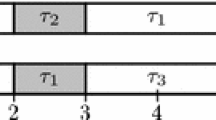Abstract
A distributed hard real time system can be composed from a number of communicating tasks. One of the difficulties with building such systems is the problem of where to place the tasks. In general there are P T ways of allocating T tasks to P processors, and the problem of finding an optimal feasible allocation (where all tasks meet physical and timing constraints) is known to be NP-Hard. This paper describes an approach to solving the task allocation problem using a technique known as simulated annealing. It also defines a distributed hard real-time architecture and presents new analysis which enables timing requirements to be guaranteed.
Similar content being viewed by others
References
Aarts, E.H.L. and Korst, J., 1988. Simulated Annealing and Boltzmann Machines. New York: Wiley-Interscience.
Audsley, N.C., Burns, A., Richardson, M.F. and Wellings, A.J., 1990. Hard real-time scheduling: The deadline monotonic approach. Proceedings 8th IEEE Workshop on Real-Time Operating Systems and Software, Atlanta, USA (May 15–17).
Bannister, J.A. and Trivedi, K.S., 1983. Task allocation in fault-tolerant distributed systems. Acta Informatica 20: 261–281.
Bollinger, S. and Midkiff, F., 1990. Heuristic technique of processor and link assignment in multicomputers. IEEE Transactions on Computers 40: 325–333.
Burns, A., 1990. Scheduling hard real-time systems: A review. Software Engineering Journal 6(3): 116–128.
Chen, G. and Yur, J., 1990. A branch-and-bound-with-underestimates algorithm for the task assignment problem with precedence constraint. 10th International Conference on Distributed Computing Systems, pp. 494–501.
Chu, W.W. and Lan, L.M., 1987, Task allocation and precedence relations for distributed real-time systems. IEEE Transactions on Computers A02: 667–79. IEEE Trans. Comput. (USA).
Damm, A., Reisinger, J., Schwabl, W. and Kopetz, H., 1989. The real-time operating system of MARS. ACM Operating Systems Review 23(3 (Special Issue)): 141–15.
Houstis, C.E., 1990. Module allocation of real-time applications to distributed systems. IEEE Transactions on Software Engineering, 16(7): 699–709, IEEE Trans. Softw. Eng. (USA).
Kirkpatrick, S., Gelatt, C.D. and Vecchi, M.P., 1983. Optimization by simulated annealing. Science (220): 671–680.
Laarhoven, P.J.M. and Aarts, E.H.L., 1987. Simulated Annealing: Theory and Applications. D. Reidel Publishing.
Lehoczky, J., Sha, L. and Ding, Y., 1989. The rate monotonic scheduling algorithm: Exact characterization and average case behavior, Proceedings of the Real-Time Systems Symposium.
Leung, J.Y.T. and Whitehead, J., 1982. On the complexity of fixed-priority scheduling of periodic real-time tasks. Performance Evaluation, vol. 2, (4); 237–250.
Liu, C.L. and Layland, J.W., 1973. Scheduling algorithms for multiprogramming in a hard real-time environment. Journal of the ACM, 20(1): 46–61.
Price, C.C. and Salama, M.A., 1980. Scheduling of precedence-constrained tasks on multiprocessors. The Computer Journal 33 (3): 219.
Radcliffe, N. and Wilson, G., 1980. Natural solutions give their best. New Scientist, pp. 47–50.
Ramamrithamn, K., 1980. Allocation and scheduling of complex periodic tasks. 10the International Conference on Distributed Computing Systems, pp. 108–115.
Roussel-Ragot, P. and Dreyfus, G., 1990. A problem independent parallel implementation of simulated annealing: Models and experiments. IEEE Transactions on Computer-Aided Design, 9 (8).
Tindell, K., 1990. Allocating real-time tasks (An NP-hard problem made easy). YCS 149, Department of Computer Science, University of York.
Varbosa, V. and Boeres, M.C., 1990. An occam based evaluation of a parallel version of simulated annealing. Microprocessing and Microprogramming, pp. 85–92, Euromicro '90.
Author information
Authors and Affiliations
Additional information
This work was supported in part by British Aerospace (Commercial Aircraft) Ltd, and the UK Department of Trade and Industry.
Rights and permissions
About this article
Cite this article
Tindell, K.W., Burns, A. & Wellings, A.J. Allocating hard real-time tasks: An NP-Hard problem made easy. The Journal of Real-Time Systems 4, 145–165 (1992). https://doi.org/10.1007/BF00365407
Issue Date:
DOI: https://doi.org/10.1007/BF00365407




